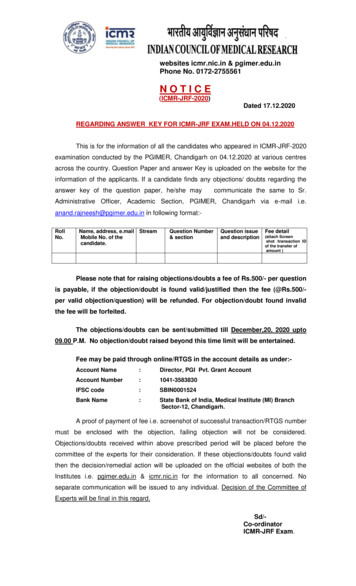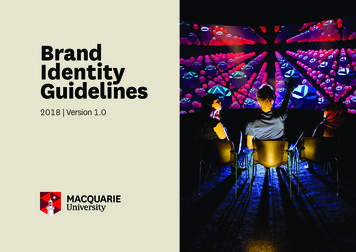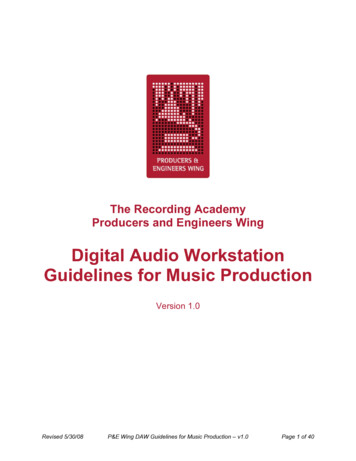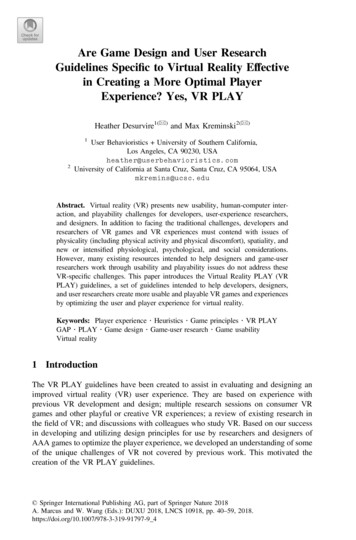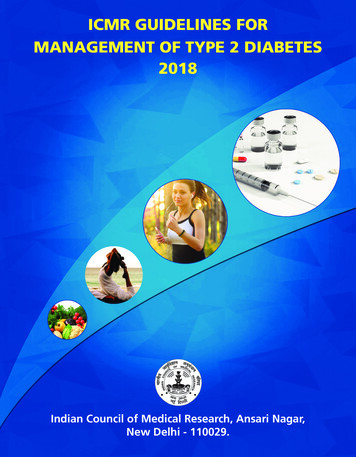
Transcription
ICMR GUIDELINES FORMANAGEMENT OF TYPE 2 DIABETES2018Indian Council of Medical Research, Ansari Nagar,New Delhi – 110 029
ICMR GUIDELINES FOR MANAGEMENT OF TYPE 2 DIABETES 2018S.NOCONTENTSPAGE ECTION 1 : INTRODUCTION1.1Definition11.2Epidemiology11.3Types of diabetes11.4Differentiating between type 1 and type 2 diabetes21.5Goals for management41.6Diabetes education41.7Prevention of diabetes5SECTION 2 : SCREENING FOR TYPE 2 DIABETES2.1Whom and when to screen?72.2How to screen?72.3Where to screen?82.4Retesting82.5Other aspects8SECTION 3 : DIAGNOSTIC CRITERIA3.1Diagnostic criteria for diabetesICMR Guidelines for Management of Type 2 Diabetes 20189
3.2Symptoms of diabetes93.3Criteria for the diagnosis of prediabetes93.4Oral Glucose Tolerance Test (OGTT)103.5Testing for type 2 diabetes in children and adolescents11SECTION 4 : TARGETS FOR CONTROL OF DIABETES4.1Targets for metabolic control in diabetes124.2Glycemic targets during pregnancy13SECTION 5 : MONITORING AND FOLLOW-UP OF PEOPLEWITH DIABETES5.1How to monitor and follow up people with diabetes?145.2Self monitoring with blood glucose (SMBG) with glucosemonitor145.3What to do during Annual check up15SECTION 6 : NON-PHARMACOLOGICAL MANAGEMENT OFDIABETES6.1Lifestyle goals in diabetes166.2Medical Nutrition Therapy (MNT)166.3Physical activity and exercise216.4Yoga and diabetes22SECTION 7 : PHARMACOLOGICAL MANAGEMENT OFDIABETES7.1Anti-hyperglycemic drugs247.2Insulin therapy397.3Non-insulin injectable therapy (GLP-1 receptor agonists)47ICMR Guidelines for Management of Type 2 Diabetes 2018
SECTION 8 : COMPLICATIONS OF DIABETES8.1Acute complications488.2Chronic complications498.3Coronary artery disease518.4Diabetic nephropathy528.5Diabetic retinopathy548.6Diabetic neuropathy568.7Diabetic foot57SECTION 9 : DIABETES AND PREGNANCY9.1Pre-gestational diabetes639.2Gestational diabetes mellitus (GDM)639.3Management of hyperglycemia in pregnancy659.4Post-partum follow up66SECTION 10 : COMORBID Obesity6810.4Tuberculosis68SUMMARY OF GUIDELINES69ICMR Guidelines for Management of Type 2 Diabetes 2018
ICMR Guidelines for Management of Type 2 Diabetes 2018i
ICMR Guidelines for Management of Type 2 Diabetes 2018ii
Dr. Tanvir KaurScientist ‘F’Non Communicable DiseaseIndian Council of Medical ResearchICMR Guidelines for Management of Type 2 Diabetes 2018iii
PREAMBLEDiabetes has become a global problem and the epidemic is most pronounced in South East Asia particularlyIndia where an estimated 72 million people are believed to have diabetes and another 80 million have pre-diabetes.More than 90 – 95% of all patients with diabetes have type 2 diabetes. The treatment of type 2 diabetes has undergonerapid changes in the last decade, and several new drugs have been introduced in the market.In 2005, the Indian Council of Medical Research (ICMR) brought out the ‘Guidelines for Management ofType 2 Diabetes’ as a small book and this has found wide application all over India. As more than a decade haselapsed since the publication of that document, ICMR felt that a revision of the Guidelines for Management of Type2 Diabetes was indicated. An expert group was constituted by ICMR, to look at the old guidelines and to suggestmodifications as may be needed, based on the latest developments in the management of type 2 diabetes.After several rounds of iteration, a document was prepared which was then circulated to a few additionalexperts. After getting the comments from these experts, an ICMR Workshop entitled ‘ICMR GUIDELINES FORMANAGEMENT OF TYPE 2 DIABETES 2018’ was held at Chennai on 10th January 2018 and a group of experts wasinvited by ICMR. The Workshop was divided into different sections. Each part of the document was studied in detailand necessary changes were made to the document. The document was then placed in the ICMR website, giving anopportunity for anyone else who wished to view the documents and give their comments or suggestions to do so. Afew additional suggestions were received which were also incorporated in the final document.We now have great pleasure in publishing the ‘ICMR Guidelines for Management of Type 2 Diabetes 2018’.We trust that this booklet will be useful not only for practicing physicians and general practitioners but also for medicalstudents (both undergraduates and postgraduates) and also for nurses, educators and other paramedical personnel.We welcome feedback and suggestions from readers so that when the next set of guidelines is prepared by ICMR,these suggestions can be incorporated.We also wish to thank ICMR for their guidance and support and all the experts for the time and effort theyspent in making this document. A special word of thanks to Dr. Ranjit Unnikrishnan who painstakingly compiled all thesuggestions and comments and helped finalize the document.Dr. Nikhil Tandon,Professor & Head,Department of Endocrinology,All India Institute of Medical Sciences,Ansari Nagar,New DelhiDr. V. Mohan,Director,Madras Diabetes Research Foundation &Dr. Mohan’s Diabetes Specialties Centre,4, Conran Smith Road, GopalapuramChennaiICMR Guidelines for Management of Type 2 Diabetes 2018iv
SECTION 1INTRODUCTION1.1 DefinitionDiabetes mellitus is a syndrome of multiple etiologies characterized by chronichyperglycaemia with disturbances of carbohydrate, fat and protein metabolismresulting from defects in insulin secretion, insulin action or both. This disorder is oftenassociated with long term complications, involving organs like eyes, kidneys, nerves,heart and blood vessels.1.2 EpidemiologyIn recent decades, India has witnessed a rapidly exploding epidemic of diabetes.Indeed, India today has the second largest number of people with diabetes in theworld. The International Diabetes Federation (IDF) estimates that there are 72.9 millionpeople with diabetes in India in 2017, which is projected to rise to 134.3 million by theyear 2045. The prevalence of diabetes in urban India, especially in large metropolitancities has increased from 2% in the 1970s to over 20% at present and the rural areasare also fast catching up.1.3 Types of diabetesAccording to the American Diabetes Association and the World Health Organisation,diabetes can be classified into four main types (see Box).Classification of Diabeteszz Type 1 diabeteszz Type 2 diabeteszz Gestational diabeteszz Other types of diabetes (Monogenic diabetes, pancreatic diabetes,drug-induced diabetes etc.)ICMR Guidelines for Management of Type 2 Diabetes 20181
Of these, the two most important forms of diabetes are type 1 and type 2 diabetes.Type 1 diabetes is primarily due to autoimmune-mediated destruction of pancreaticbeta cells, resulting in absolute insulin deficiency and thus requiring insulin for goodhealth and survival. While type 1 diabetes is also on the increase, the actual numbersof people with type 1 diabetes in India is, relatively speaking, still small. Type 2diabetes, on the other hand, accounts for over 90-95% of all people with diabetes andis characterized by insulin resistance and abnormal insulin secretion, either of whichmay predominate. The diabetes epidemic relates particularly to type 2 diabetes,and predominantly due to the changing lifestyles, urbanization, demography andincreased longevity.1.4 Differentiating Between Type 1 and Type 2 DiabetesTable 1.1 below provides a few clinical points to differentiate between type 1 and type2 diabetes.Table 1.1 Points to differentiate between type 1 and type 2 diabetesType 1 diabetesType 2 diabetesAge at diagnosisUsually childhood andadolescence, but can occurin adults as wellUsually postpubertal;most common in middle tolater age groupsDiabetes in 1st degreerelativeUnusualCommonSevere osmoticsymptoms/ Ketosis atdiagnosisCan occurRareMarkers of insulinresistanceAbsentPresentC-peptide assayAbsence of beta-cell reservePreserved entICMR Guidelines for Management of Type 2 Diabetes 20182
Type 1 diabetes will not be discussed further in these guidelines and they pertainchiefly to type 2 diabetes.Type 2 diabetes is a metabolic-cum-vascular syndrome characterized bypredominant insulin resistance with varying degrees of insulin secretory defect. Itis a progressive disease often associated with central obesity, dyslipidaemia andhypertension. It is more common in overweight and obese individuals of middle tolate age but is increasingly being seen in younger age groups and in those with lowerbody mass index (BMI) as well. The “Asian Indian phenotype” refers to a peculiarconstellation of abnormalities in south Asians, whereby for any given level of BMI,they tend to have higher total body fat, visceral fat, insulin resistance and prevalenceof diabetes compared to white Caucasians (Figure 1.1).Figure 1.1: The “Asian Indian phenotype”Greater ethnic susceptibility and genetic familialaggregation of type 2 diabetesLower age at onset ofType 2 diabetesLow birth weight – thin fatIndianLower threshold forBMI for diabetesInflammatorymarkers; CRPAbdominalobesity andvisceral fatASIAN INDIANPHENOTYPESerum insulinlevels/ insulinresistanceCharacteristicdyslipidemia:Levels of adiponectinHDL cholesteroltriglycerides &small dense LDLIncreased prevalence of type 2 diabetes / premature CVDICMR Guidelines for Management of Type 2 Diabetes 20183
1.5 Goals for managementzz Relief from symptoms of diabetes and improvement in quality of lifezz Glycemic control and prevention of acute complicationszz Identificationand management of comorbid conditions like obesity,hypertension and dyslipidaemiazz Prevention of microvascular complications like retinopathy, neuropathy andnephropathyzz Preventionof macro-vascular complicationscerebrovascular and peripheral vascular diseaselikecardiovascular,zz Prevention of infectionsThe complete treatment of people with diabetes requires advocating a healthy lifestyle with focus on increased physical activity and a proper balanced diet in additionto prescribing medications.1.6 Diabetes EducationDiabetes education means empowering people with diabetes with knowledge andLoproviding tools crucial for making them active partners in the diabetes managementteam. These include:zz In-depth information about diabetes, its complications and treatmentzz Appropriate self care skillszz Appropriate resources for self carezz A positive attitudezz Self monitoring skillsThe compliance of people with diabetes is essential for effective management ofdiabetes. Education programmes are intended to help people to understand why theseactions are so important and thereby increase their motivation for self-management.ICMR Guidelines for Management of Type 2 Diabetes 20184
1.7 Prevention of DiabetesThere is an urgent need for strategies to prevent or at least slow down the emergingepidemic of diabetes apart from treating diabetes and associated complications.Several factors are thought to contribute towards the acceleration of the epidemic,the most important being the rapid epidemiological transition due to urbanization andlife style changes. Identifying individuals at risk is essential in planning preventivemeasures. Prevention of diabetes has several windows of opportunities (Figure 1.2).Figure 1.2: Levels of prevention of s DisabilityICMR Guidelines for Management of Type 2 Diabetes 2018Death5
The three stages of prevention are:1.7.1 Primordial prevention attempts to reduce the risk factors for diabetes, e.g.,reducing or preventing obesity to reduce the future risk of diabetes.1.7.2 Primary prevention targets people who are in the stage of prediabetesto prevent the onset of diabetes. All people with prediabetes should be regularlyscreened and encouraged at each health care visit to pursue a healthy life-style,including a healthy diet, adequate exercise and weight control in order to preventdiabetes. Several studies including from India have shown that diabetes can beprevented in up to a third of people with prediabetes. When lifestyle alone is notsufficient and especially in those with combined IFG and IGT where progression totype 2 diabetes appear imminent, use of metformin in addition to lifestyle measuresmay be considered especially in Indians who progress rapidly to diabetes from theprediabetes stage.1.7.3 Secondary prevention is to prevent the onset of complications in thosewho are already diagnosed to have diabetes. This can be achieved by meticulouscontrol of diabetes with the help of diet, physical activity, life style modification andantihyperglycaemic drugs as indicated. Control should include holistic care beyondglycemic control i.e. attention to blood pressure, lipids etc.1.7.4 Tertiary prevention of diabetes is aimed at limiting physical disability andrehabilitation measures in those who have already developed diabetic complicationsand preventing them from going into end stage complications of diabetes.ICMR Guidelines for Management of Type 2 Diabetes 20186
SECTION 2SCREENING FOR TYPE 2 DIABETESType 2 diabetes occurs a much earlier age (at least a decade earlier) in Indianscompared to other major ethnic groups. Screening of asymptomatic individualsallows diagnosis of diabetes and prediabetes to be made at an earlier stage andthus appropriate management can be instituted. In addition, it provides an opportunityfor screening of cardiovascular disease (CVD) risk factors and the institution ofinterventions for their control. Early detection of diabetes has been shown to improveoutcomes.2.1 Whom and when to screen?Screening should be performed in all individuals 30 years of age. It should be carriedout at an earlier age in adults who have one or more of the following risk factors:zz Family history of diabeteszz Overweight/obese (BMI 23 kg/m2) or have increased waist circumference( 90 cm males, 80 cm females)zz History of hypertension ( 130/80 mmHg) or on treatment for hypertensionzz History of dyslipidaemiazz Sedentary physical activityzz History of gestational diabetes or macrosomia (birth weight 3.5 kg)zz History of CVD (ischaemic heart disease, cerebrovascular disease)zz History of polycystic ovarian syndrome and/or acanthosis nigricans2.2 How to screen?Screening can be done by fasting plasma glucose, an oral glucose tolerance test(OGTT) using 75 gm glucose or a random plasma glucose. Glycosylated (glycated)haemoglobin (HbA1c) is also recommended for screening; however, in India there aresome limitations regarding its use.ICMR Guidelines for Management of Type 2 Diabetes 20187
2.3 Where to screen?Preferably, screening should be done in a health care setting. Alternatively,community screening can also be done.2.4 Retesting:Retesting should be done after 3 years in case of normal glucose tolerance. Incase of prediabetes, it should be done annually.2.5 Other aspects:CVD risk factors such as hypertension, dyslipidemia, tobacco use and case ofsedentary lifestyle should be identified and treated.ICMR Guidelines for Management of Type 2 Diabetes 20188
SECTION 3DIAGNOSTIC CRITERIA3.1 Diagnostic Criteria for Diabeteszz Symptoms of diabetes (see Section 3.2) plus casual or random plasmaglucose 200 mg/dl (Casual means without regard to time of last meal)zz Fasting plasma glucose 126 mg/dl*zz 2 hour post 75 g glucose 200 mg/dl (as part of OGTT)*zz Glycated Haemoglobin 6.5%**Diabetes diagnosed using any of these criteria should be confirmed with anothertest subsequently.3.2 Symptoms of Diabeteszz Osmotic symptoms- polyuria, polydipsiazz Weight loss in spite of polyphagiazz Tiredness, weaknesszz Generalised prurituszz Recurrent urogenital infectionszz Delayed healing of woundsMore than half of all patients with diabetes will have no symptoms at all3.3 Criteria for the Diagnosis of PrediabetesThe term “prediabetes” refers to a situation where the blood glucose levelsare higher than normal, but not high enough to warrant a diagnosis of diabetes.Prediabetes consists of two entities viz. impaired fasting glucose (IFG) and impairedgluose tolerance (IGT).ICMR Guidelines for Management of Type 2 Diabetes 20189
The diagnostic criteria for diabetes and prediabetes are summarized inTable 3.1Table 3.1: Diagnostic criteria for diabetes and etes (mg/dl)WHOADAWHOADA 110 100110-125(IFG)100-125(IFG)2-h PG 140140-199 (IGT)HbA1c 5.7%5.7-6.4%Randomplasmaglucose*Diabetes (mg/dl) 126 200 6.5% 200 (withsymptoms ofdiabetes)* Individuals with random plasma glucose between 140-199mg/dl are recommended to undergo OGTTWHO - World Health Organisation; ADA-American Diabetes Association; IFG - Impaired Fasting Glucose;IGT - Impaired Glucose tolerance; FPG - Fasting Plasma Glucose; 2-h PG-2 hour post load Glucose test(oral glucose tolerance test) plasma glucose; HbA1c – Glycosylated Haemoglobin3.4 Oral Glucose Tolerance Test (OGTT)zz Person to be tested should be on a normal diet (with at least 200 g carbohydrate/day) for at least 3 days before the testzz The test should be done after an overnight fast of 8-10 hours and comprisesof two blood samples: fasting and 2 hours after glucose loadzz Following the collection of the fasting blood sample for analysis of plasmaglucose, the individual should be administered 75 g of glucose (1.75 g/ kgbody weight for children to a maximum of 75 g) dissolved in at least 250 ml ofwater. The glucose load should be drunk within a period of 5 minutesThe second sample should be collected 2 hours after the glucose load is given.The subject should be resting and refrain from smoking and eating in between the twosample collections.ICMR Guidelines for Management of Type 2 Diabetes 201810
3.5 Testing for Type 2 Diabetes in Children and AdolescentsChildren and adolescents aged 18 years and below should be screened fordiabetes if they are overweight (weight 120% of ideal body weight) and have any ofthe following risk factors:zz Family history of type 2 diabetes in first degree relativeszz Signs of insulin resistance (Acanthosis nigricans)zz Hypertensionzz Dyslipidaemiazz Polycystic Ovary Syndrome (PCOS)ICMR Guidelines for Management of Type 2 Diabetes 201811
SECTION 4TARGETS FOR CONTROL OF DIABETESAny target is only a general guideline, and individualized targets are to beestablished. Tight glycemic control is essential in the early stages of diabetes,especially in the young to prevent complications. With the onset of complicationsand in the elderly, targets need to be revised based on the condition of the patient.4.1 Targets for metabolic control in diabetesBlood glucose, blood pressure, BMI, waist circumference and lipid targets for apatient with diabetes are listed in Table 4.1 and Table 4.2 below.Table 4.1: Targets for metabolic control in diabetesIdealSatisfactoryUnsatisfactoryFasting Plasma Glucose (mg/dl) 80 -110111 - 125 1252 hour Postprandial Glucose120 - 140(mg/dl)141 - 180 180Blood pressure (mm Hg) 130/80 140/90 140/90Body Mass Index (kg/m2)20 - 2323.1 - 25 257- 88Waist (cm)Men 90Women 80Glycated Haemoglobin [HbAlc] 7(%)ICMR Guidelines for Management of Type 2 Diabetes 201812
Table 4.2 Targets for lipid control in diabetesTotal Cholesterol (mg/dl)HDL Cholesterol (mg/dl) 200 40 for men 50 for womenLDL Cholesterol (mg/dl) 100*Non-HDL Cholesterol(mg/dl) 130Triglycerides (mg/dl) 150*For those at high risk (established CVD, smoking, obesity, hypertension, familyhistory of premature CVD and evidence of other vascular disease), LDL cholesterol 70mg/dl is recommended4.2. Glycemic targets during pregnancyTight glycemic control is most essential during pregnancy. Glycemic targets duringpregnancy are presented in Table 4.3.Table 4.3: Glycemic targets during pregnancyIdealFasting Plasma Glucose (mg/dl) 901 hour Postprandial Glucose (mg/dl) 1402 hour Postprandial Glucose (mg/dl) 120Physician may request for either for a 1 hour or 2 hour postprandial blood glucosevalue for purposes of monitoring.ICMR Guidelines for Management of Type 2 Diabetes 201813
SECTION 5 MONITORING AND FOLLOW UP OF PEOPLE WITH DIABETES5.1 How to Monitor and Follow up People with Diabetes?zz Blood glucose - FPG and 2 hr PPPG at least once a month and more often ifvalues are not in the ideal target rangezz HbA1c at least every 6-12 months and more often (every 3 months) if valuesare not in the ideal target range, or tight control is being attemptedzz Clinical examination needs to be done during every visit--- minimum every 3monthszz Screening for long term complications like retinopathy, nephropathy,neuropathy, peripheral vascular disease (PVD) and coronary artery disease(CAD) at least once a year, more often if needed (see Section 8)zz Optimizing weight, waist, blood pressure, lipidszz Routine examination of foot to be done during every visit & education regardingfoot care to be given to patients in each visitzz Discourage tobacco use and excess use of alcoholUrine glucose monitoring is not recommended. Urine examination for estimation ofketones should be done if blood glucose is greater than 400 mg/dl.5.2 Self Monitoring of Blood Glucose (SMBG) with Glucose MonitorIt is indicated in the following conditions:zz Ideal for every patient to achieve better control of diabeteszz All people with diabetes on insulinzz Brittle diabeteszz Those prone to ketosis/recurrent hypoglycaemiazz Hypoglycaemia unawarenessICMR Guidelines for Management of Type 2 Diabetes 201814
zz Whenever tight control is indicated — pregnancy, acute illness andcomplicationszz Frequency of SMBG should be individualised (e.g. with greater frequency inpregnancy)5.3 What to do during Annual Check-Up?zz Basic clinical exam including detailed foot exam with palpation of dorsalispedis and posterior tibial pulses, monofilament and vibration perceptiontesting (VPT) (See Section 8)zz Retinal check-up (fundus examination for retinopathy)zz Blood urea / serum creatininezz Urine — protein/albumin, micro-albuminuria if available or at least UrinaryAlbumin by dipstickzz ECGzz Lipidszz Hemogramzz Urine routinezz Diet/ exercise to be reinforcedzz Psychological support whenever necessaryzz Tests to be carried out when indicated: X Ray chest, uric acid, TSH, SGOT,SGPT, vitamin B12, electrolytes, ultrasound abdomenAdvanced monitoring can be done if required in case of recurrent hypoglycaemia,severe fluctuations in blood glucose, disparity in measured glucose values andHbA1c, severe anaemia, haemoglobinopathy, hypoglycaemia unawareness etc. HereContinuous Glucose Monitoring (CGM) for 5-7 days or iSCGM (intermittently scannedCGM) for 14 days may be used.ICMR Guidelines for Management of Type 2 Diabetes 201815
SECTION 6NON-PHARMACOLOGICAL MANAGEMENT OF DIABETES6.1. Lifestyle Goals in Diabeteszz To improve health through optimum nutritionzz To provide energy for reasonable body weight , normal growth and developmentzz To maintain glycemic controlzz To achieve optimum blood lipid levelszz To individualise the diet according to complications and co-morbiditieszz Achieve optimal physical activityzz Advise other behavioural changes for: smoking, other tobacco products andalcoholzz Advocate stress management6.2 Medical Nutrition Therapy (MNT) for diabetes mellitus requires application ofnutritional and behavioral sciences along with physical activity.We need a four-pronged approach:zz Nutritional assessment which includes metabolic, nutritional and life styleparameterszz Setting goals – practical, achievable and acceptable to the patient--individualisedzz Nutritional Intervention, including nutrition education – individualized mealplans according to family eating patternszz Evaluation – to assess if the goals have been achieved and to make necessarychangesICMR Guidelines for Management of Type 2 Diabetes 201816
Based on factors like age, sex, physical activity, height, weight, body mass index(BMI) and cultural factors, the diet is planned. The diet should be individualized, closeto the family pattern, flexible, should have variety and meal timing should be accordingto the patient’s daily schedule.6.2.1 Dietary Recommendations:(i) Energy:Sufficient to attain or maintain a reasonable body weight for adults, normal growthand development for children and adolescents, to meet the increased needs duringpregnancy and lactation and recovery from illness. Daily physical activity and exerciseneeds to be considered.Ideal Body Weight (IBW) (Height in cm – 100) * 0.9.Approximately, 25 kcals/kg ideal body weight/day can be given to a moderatelyactive patient with diabetes. The change in the daily calorie should be a gradualprocess, and not more than 500 calories/day.(ii) Energy or Calorie Distribution:(a) Carbohydrates:Evidence is inconclusive for an ideal amount of carbohydrate intake for peoplewith diabetes. Therefore, collaborative goals should be developed for individualswith diabetes. 55-60 % of energy from carbohydrates is an ideal recommendation.Carbohydrates should be complex in nature. Although different carbohydrates producedifferent glycemic responses, from clinical point of view it is important to manage totalcarbohydrate. It is recommended that carbohydrates from foods high in fibre e.g.whole grains (unpolished cereals and millets), legumes, peas, beans, oats, barleyand some fruits with low glycemic index and glycemic load are consumed. All patientswith diabetes should be encouraged to take 6 small meals a day. Food exchangesystem can be followed to give more variety and individualization to the diet plan.ICMR Guidelines for Management of Type 2 Diabetes 201817
(a) Fibre:Fibre recommendation for general population is 40 g/day (2000 Kcals).Traditional Indian diets that include whole grains along with whole pulses likegrams, soy, green leafy vegetables and some fruits is the recommendation. Fruits likepapaya, guava, apples, pears, oranges, mosambi can be taken in moderation. All fruitjuices are best avoided.(b) Proteins:Proteins should provide 12-15 % of the total energy intake for people with diabetes –similar to the recommendations for the general population.Proteins from vegetable sources like pulses, soy, grams, peas as well as form lowfat milk, low fat curds, fish and lean meats are recommended.Supplementation of foods like cereal and pulse (4:1 ratio) can improve the proteinquality and also gives satiety. For e.g; Idli, dosa, Missi roti, Khichdi, Dhokla, Khandvietc.(c) Fats:Fats should provide 20-30 % of total energy intake for people with diabetes.Evidence is inconclusive for an ideal amount of total fat intake for people withdiabetes, therefore, goals should be individualized. Fat quality is as important as thequantity.Fat qualityzz Saturated fats (SFA) 10% energy and 7% in those with raised blood lipidlevelsICMR Guidelines for Management of Type 2 Diabetes 201818
zz Polyunsaturated fats (PUFA) 10 % energy, n6: 3-7% energy, n3: 1% energy,n6/n3 ratio 5-10zz Monounsaturated Fatty Acids (MUFA) 10-15% energy any calories left fromthe carbohydrate portionzz Trans fats 1% energy – preferably totally avoidedIn people with type 2 diabetes, MUFA-rich cooking oil and nuts in moderation maybenefit glycemic control and CVD risk factors. This can therefore be recommendedas an effective alternative to a lower-fat, higher-carbohydrate eating pattern. Use ofMUFA rich oils like mustard, rice bran, peanut (groundnut) and gingelly are goodoptions. Oils rich in n6 PUFA like safflower, sunflower, cotton seed, should be mixedwith oils rich in n3 like soy and mustard to maintain N6:N3 ratio between 5-10. Useof mixed oils or alternating of oils is recommended.(iii) Salt:Sodium intake recommendations for people with diabetes are the same as that forthe general population. Added (iodized) salt should be less than 5 g/day. For personswith hypertension and diabetes, the intake should be reduced to less than 3 g/ day.In hypertensive patients or edematous patients with nephropathy, sodium restrictionis required. All preserved and processed foods such as pickles, chutneys, packagednamkeens/savouries, sauces should be restricted.(iv) Alcohol:It is best to avoid alcohol, however if used, should be taken in moderation. If alcoholis consumed, it should not be counted as part of the meal plan. However, it should beborne in mind that alcohol does provide calories (7 kcal/ g), which are considered as“empty calories”. In the fasting state, alcohol may produce hypoglycaemia. Alcoholcan further exacerbate fatty liver, neuropathy, dyslipidaemia, obesity and also worsenblood glucose levels.ICMR Guidelines for Management of Type 2 Diabetes 201819
(v) Sweeteners:Nutritive Sweeteners : These include fructose, honey, corn syrup, molasses, fruitjuice or fruit juice concentrates dextrose, maltose, mannitol, sorbitol and xylitol. Allthese are best avoided.Non-nutritive Sweeteners : Aspartame, acesulfame K, stevia, sucralose andsaccharin are currently approved for use. However, they should be used in moderationand are best avoided in pregnancy.6.2.2 Dietary modifications in the presence of complications of diabetes:(i) Nephropathy:(a) Protein : The recommended protein intake for diabetic nephropathy patients is0.6 g/kg of the ideal body weight plus 24 hour urinary protein loss, if this is significant.However, it is recommended that the protein intake should not be less than 40 g/day. For patients with increased creatinine, protein restriction should be advised inconsultation with the nephrologist.(b) Sodium: It could vary from 1000 mg to 2000 mg/day depending upon the fluidstatus and serum sodium levels.(c) Potassium: Potassium restriction may be required depending upon thepotassium values in the blood and type of diuretic being used.(ii) Cardiovascular Disease:(a) Maintaining an optimal body weight and restricting salt. Use of fruits andvegetabl
After several rounds of iteration, a document was prepared which was then circulated to a few additional . fat and protein metabolism resulting from defects in insulin secretion, insulin action or both. This disorder is often . style with focus on increased physical activity and a proper balanced



